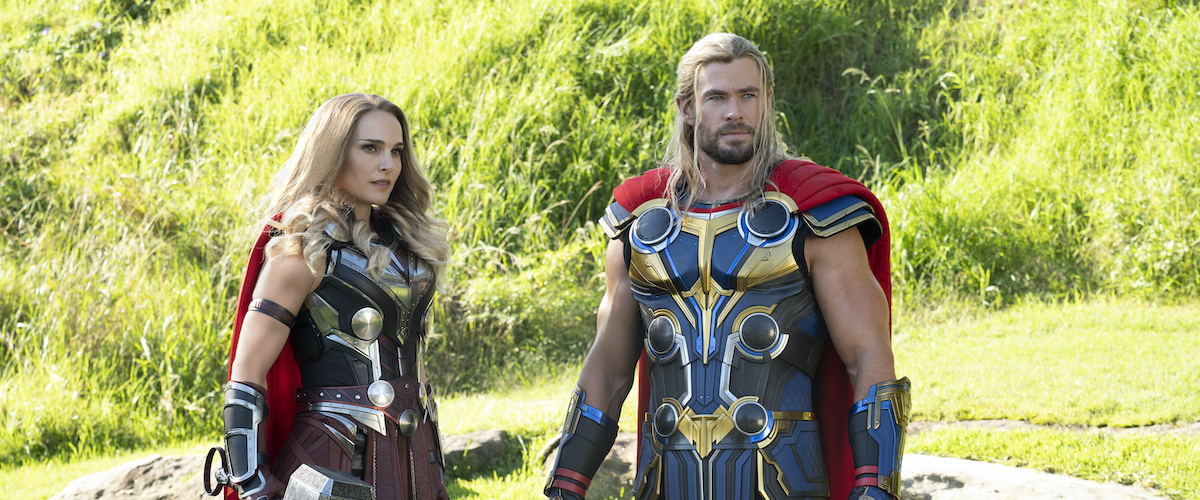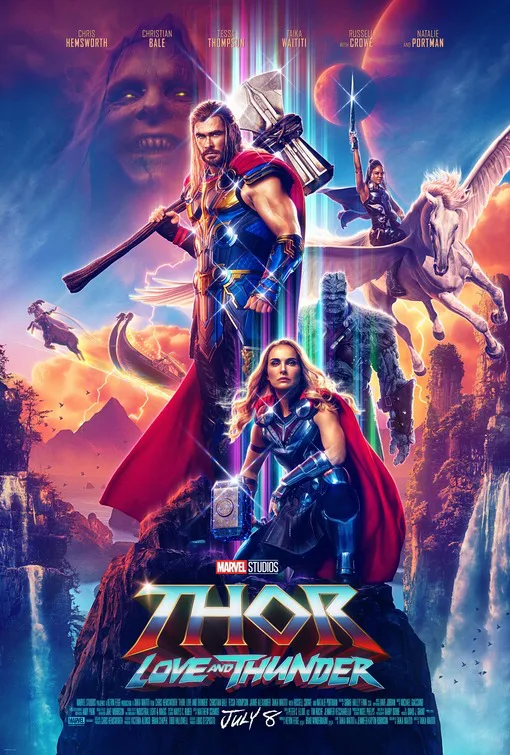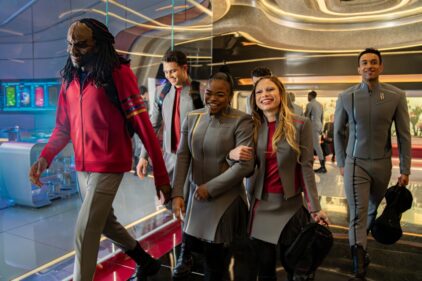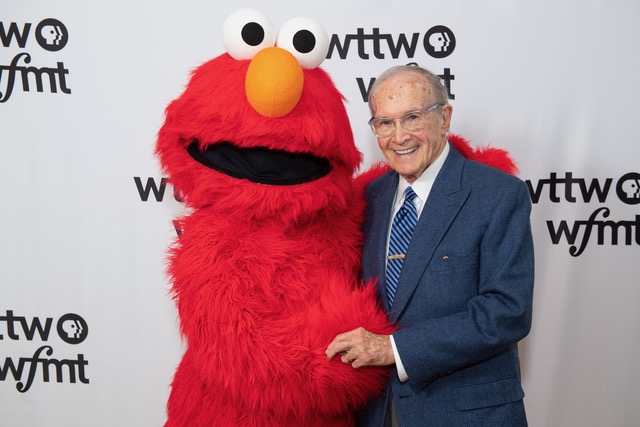“Thor: Love and Thunder” is more or less a victory lap for all that director Taika Waititi achieved with his previous Marvel film, the often hilarious, rousing, and plainly refreshing “Thor: Ragnarok.” And while it has too many familiar flourishes and jokes, this entertaining sequel is still a force for good, with enough visual ambition and heart in front of and behind the camera to stand on its own.
We meet our space Viking hero and thunderous Norse god Thor (Chris Hemsworth) on a path of healing. Going “from dad bod to god bod” (to quote Waititi’s voiceover recap, delivered by his still-charming rock-bodied softy character Korg), Thor has lost the gut he had in “Avengers: Endgame,” and the people of Asgard have settled into a port town called New Asgard after their home realm was trashed in “Thor: Ragnarok.” Their leader, the charismatic King Valkyrie (Tessa Thompson), has helped them acclimate to life on Earth, which includes being a tourist attraction. With the assistance from the Guardians of the Galaxy in a brief appearance, Thor gets back into worlds-saving shape, and in a Guns N’ Roses-accompanied moment, in the beginning, he unleashes stylized, high-flying slaughter a la many scenes in “Thor: Ragnarok,” wielding his axe Stormbreaker. But he has no one to share the victory with, and for all of the hundreds of years Thor has lived, he has resigned to not finding true love.
The film then re-introduces a more interesting hero in Jane Foster (Natalie Portman), Thor’s past human love interest from the previous films during his more serious days. Now, she wields the restored pieces of Thor’s hammer Mjolnir, turning into the Mighty Thor with helmet and cape, but all with a price. Every time she uses the power, it takes away from her human capacity, which is all the more devastating given that we learn she has Stage Four cancer. “Thor: Love and Thunder” thoughtfully reinstates Jane into the action, while giving some more depth to her relationship with Thor. In both her human and her heroic state, Portman’s performance conveys why it’s great to see Jane again.
The adversary this time around is Gorr the God Butcher, a tortured character filled with vengeance who provides the shadows to the movie’s immense moments of light. After the death of his daughter turns him into a non-believer, Gorr is chosen by a weapon called the Necrosword, and creates an army of shapeshifting black beasts to kill all gods, starting with the one who ignored his cries for help. Christian Bale is striking in the role, fluctuating between high and low voices, relishing the chance to brandish his sharp teeth. It’s the closest we’ll get to seeing him play Pennywise the Clown, with a dash of Voldemort, but tethered to the same humility Bale brings to his most human, humbled characters. He can be mighty fun to watch, even when “Thor: Love and Thunder” undersells his god butchering for the sake of a more sentimental message, and to make him share scenes with frightened children.
Co-written by Waititi and Jennifer Kaytin Robinson, “Thor: Love and Thunder” just doesn’t truly flourish as it could. Part of its messiness kicks in with its big conflict when Gorr the God Butcher attacks New Asgard at night in a frantic impromptu fight scene that has Waititi’s usually stable vision for Thor action losing control. The supposedly scary scene just happens, and it’s difficult to follow in the dark what’s going on, as shadow creatures wage battle on the Asgardians and kidnap their children. The sequence is so disjointed that a visual gag involving a collapsing burning building in the background—timed for when Thor meets cute again with Jane as a hammer-wielding, ass-kicking, Mighty Thor—just doesn’t work.
In order to stop Gorr and save the stolen children, Jane, Thor, King Valkyrie, and Korg visit the god of lightning Zeus and the other Gods, who laze about in a golden forum and talk about the next orgy, unafraid of what Gorr is looking to do to them. Like a golden and white version of the Galactic Senate in “Star Wars,” with a grab-bag of goofy creatures (one has furry feet and a face, that’s it; another is a Korg relative) it makes for one of the more eye-popping set pieces. But it’s also a moment in which the movie is building toward future “Thor” stories at the detriment of this one, including a shrugging cameo seen in the post-credits. It’s also a passage among many in which it’s clear that Tessa Thompson’s character of King Valkyrie, though important with the goings-on of New Asgard, has oddly been pushed to the side despite her established importance and swagger in “Thor: Ragnarok.”
“Thor: Love and Thunder” flirts with when a call-back story beat or joke is just playing the hits, the same way that there are a million Guns N’ Roses nods and needle drops in this movie just because, and you’re expected to head-bang each time. All of its pop culture ad-libs, or punched-up superhero stuff about coming up with catchphrases—when those jokes feel safe instead of left-field, they fall particularly flat. “Thor: Love and Thunder” is a blockbuster comedy sequel at its core, and its weaker material reminds you of that even when it’s still good for a sporadic laugh or two.
Lacking the overall freshness that defined the previous movie, “Thor: Love and Thunder” is better with its bolder, dramatic sequences that are like mini-movies about how love comes with the price of loss. Gorr is introduced in a harrowing piece of bubble gum Ingmar Bergman, cradling his dead child and renouncing his god before killing him, all before the Marvel Studios credit card kicks in with electric guitars. Later on, Waititi presents us the Jane and Thor romance—its coziness and later its isolation—like a spin-off of his own quirky indie “Eagle vs. Shark.” It’s very funny in some moments, but with a brutal honesty always in frame, especially as the two then see if love is salvageable in the current dwindling timeline. Along with Jane’s striking cancer storyline, it’s these heartfelt moments too that reveal the true motivators behind “Thor: Love and Thunder,” even if everything is later treated in too quaint, or too eagerly crowd-pleasing a fashion to hit as hard as they clearly meant to.
The biggest takeaway from “Thor: Love and Thunder,” aside from how Waititi really should get that “Star Wars” trilogy he’s been teasing, involves his bold usage of color, visually and thematically. It’s not just the eye-popping hues, which here include soldiers for Zeus who spew golden blood or a bravura black-and-white fight sequence between Gorr and Thor on a tiny color-draining planet that uses select flashes of blue light with great effect. It’s that assured sense of tone that preaches how a movie can mix god-killing and kid-friendly crowd-pleasing moments with a gooey message about love. This sequel is not without its reservations, but Waititi continues to show just how unique these blockbusters can still be, provided their storytellers keep embracing some of their heaviest and funniest ideas.
Available in theaters on July 8th.




















